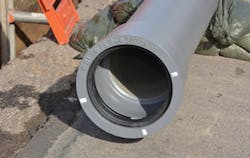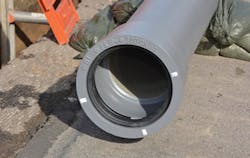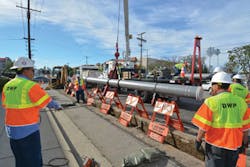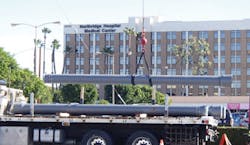Earthquake-Resistant Ductile Iron Pipe Makes U.S. Debut in Los Angeles
By Art Haddaway, WaterWorld Editor
Earthquakes pose a severe threat to critical water infrastructure across the state of California. Over the years, they have caused vast amounts of damage, including ruptures, leaks and corrosion, to many of California's aging underground water pipelines and distribution systems, ultimately leading to the substantial loss of precious water supplies. This has had profound economic, environmental and societal effects on the region, particularly on major cities such as Los Angeles and San Francisco.
Given its location, California rests atop hundreds of faults, including the San Andreas Fault, which runs about 10 miles deep, stretching 800 miles from the Salton Sea in Imperial County to Cape Mendocino in Humboldt County. According to the California Department of Conservation, 200 of these faults are considered dangerous based on their slip rates over the last 10,000 years. Further, it noted that more than 70 percent of the state's population resides within 30 miles of a fault where sizable tremors could occur over the next 50 years.
The Department also noted that California commonly experiences two to three earthquakes of a magnitude of 5.5 or higher each year, large enough to cause at least moderate damage to infrastructure, including vital water pipelines buried across several hundred miles of terrain. These distribution conduits -- many of which were built upwards of 100 years ago -- are highly susceptible to seismic occurrences and often require constant maintenance and upgrading.
It's estimated the Northridge Earthquake that occurred in L.A. in 1994, for example, crippled more than 1,000 distribution pipes and damaged seven water tanks and over 60 water transmission lines across the city, costing more than $40 million in repairs and leaving roughly 160,000 homes and business without drinking water. This is just one example of many large earthquakes that have hit California and have impacted water distribution systems as a result.
To address this, the Los Angeles Department of Water and Power (LADWP) has undertaken a groundbreaking pilot project to install high-tech earthquake-resistant ductile iron pipes (ERDIP) in key parts of the city in an effort to safeguard critical water distribution lines against the potential destructive impacts of large-scale earthquakes. Serving as the first project of its kind in the nation, the ERDIP installations along L.A.'s more than 7,000-mile aging water pipe network are expected to improve seismic reliability, conserve water by preventing breaks and leaks, and provide a dependable water supply to homes and businesses when a quake does occur.
"We are in a very extensive pipe replacement program because many of our pipes are deteriorating; they're on the order of 100 years old, and over time, we're getting an increased number of leaks and repairs that we need to take care of," said Craig Davis, LADWP manager of trunk line design and in-house earthquake expert for the L.A. water system. "We recognize that these pipes we've installed over the last century really were not considering earthquake performance. So while we're replacing these pipes, we also want to do our best to increase [their] seismic performance in future earthquakes."
The Kubota Corporation, a manufacturer focused on water and environment systems, as well as farm and industrial machinery, based out of Osaka, Japan, has been providing earthquake-resistant pipes throughout the island nation since 1974. Now, it's implementing its cutting-edge technology in the L.A. region. According to Kubota, the company's ERDIPs have withstood a variety of major quakes recorded above magnitude 6.0, including the 2011 Great East Japan earthquake reaching magnitude 9.0, with no documented damages or leaks occurring over the last 40 years. Currently, the rate of ERDIP in ductile iron pipe shipment in Japan is over 90 percent.
"The city of Los Angeles is the first user to try out the ERDIP outside of Japan," said Tomoki Ishiyama, Kubota sales manager. "We learned that the West Coast areas in the United States, including the city of Los Angeles, have seismic potential in the near future. LADWP has looked for the countermeasures against the prospective big earthquake for years. We wanted to contribute to their seismic resiliency with our products and past experiences as a company in an earthquake-prone country."
The ERDIPs feature a unique segmented design that can endure the pressure of large ground movements caused by extreme natural events such as earthquakes, landslides and temperature changes. Built to resemble a chain configuration, the system remains intact, even when different sections may move during an event. According to Ishiyama, the pipes contain bell (socket) joints that expand and contract up to 1 percent of its standard pipe length with a deflection angle of up to 8 degrees to fully absorb this lateral movement -- a higher resilience compared to conventional piping. Further, they provide a pull-out resistance force of 17,000 pounds x the pipe diameter. For example, a 4-inch (100-mm-diameter) ERDIP has the pull-out resistance force of around 68,000 pounds; this force is in proportion to the pipe size.
One of the distinctive features of the ERDIPs includes a locking device that activates after external forces exceed 1 percent, ultimately preventing pipe joints from pulling apart and breaking. "In the case of conventional push-on pipe, [they] are jointed with a rubber gasket only. If large ground movement occurs due to an earthquake, the joint may slip out," said Ishiyama. "Meanwhile, ERDIPs have a ‘locking mechanism' composed of a lock ring and spigot projection. Even when a big earthquake occurs, the joint hooks together and does not slip out."
Davis added, "The lock ring is to keep the joint from pulling apart and allowing the water to flow out of the pipe. Once it's hit its capacity, what happens is the barrel of the pipe and the forcing resistance of that lock ring is designed to pull the next length of pipe through the ground and use the capacity of the next joint, and if it still needs more capacity, it will go to the next joint. On the bottom side … you can do the same thing but in the opposite direction; it will move in compression."
The ERDIP is available in sizes from 3 to 104 inches, with pipes 16 inches and smaller featuring a special, environmentally friendly external coating called "C-protect" composed of two layers -- one of zinc alloy and the other of synthetic resin, explained Ishiyama. He noted that the zinc alloy constituent contains a "self-healing" element that successfully guards against scratches and corrosion, extending the life of the ERDIP and eliminating the need for polyethylene encasement under normal soil conditions.
The $10-million project is part of the new Resilience by Design plan recently released by Los Angeles Mayor Eric Garcetti to address various earthquake vulnerabilities, particularly relating to improving water infrastructure. It comprises five different sites based on their economic, environmental and societal vitality. Moreover, these locations "have been deemed critical to the function of the entire water system in the event of another major earthquake," according to a recent press release.
"The seismic-resilient network is intended to be placed throughout the city where known seismic hazards exist," said Davis. "We need to ensure our pipe replacement program is cost-effective to keep up with the network deterioration while simultaneously improving the seismic resilience. We are currently planning to develop a seismically-resilient pipe network targeting pipes most vulnerable to earthquake forces and those most important to distributing water to critical facilities, fighting fires and keeping our livelihood intact soon after an earthquake."
LADWP completed its first pilot site installation in the spring of 2013 in Sherman Oaks, where it placed around 1,750 feet of 6-inch-diameter ERDIP. Further, the District is currently installing the pipeline at Roscoe Boulevard's Northridge Hospital Medical Center, its second and largest pilot site, where it is installing 4,540 feet of 8-inch-diameter ERDIP and 2,006 feet of 12-inch-diameter ERDIP. Construction, which began in October 2014, is underway at various locations on Reseda Boulevard, Etiwanda Avenue, Cantara Street, and Strathern Street, and is expected to be completed in December 2015.
In the event of an earthquake, installing ERDIP at these pilot and other sites -- which sustained damage during the 1994 Northridge Earthquake -- will allow LADWP crews to focus on smaller, less time-consuming pipe repairs, essentially restoring the water supply for residents and businesses in a timely manner during a critical time, noted the press release. Likewise, earthquake damage "may be better controlled with a focus to minimize the total number of customer outages, restoring those without service more rapidly, maintaining water deliveries to critical facilities such as hospitals, and meeting post-earthquake fire flow demands," said Davis.
Later this year, LADWP will break ground on the three additional pilot sites that include the Harbor District on 94th Street, which will receive 1,310 feet of 6-inch-diameter ERDIP; the Central District on Temple Street at Figueroa, which will receive 777 feet of 6-inch-diameter ERDIP, 1,452 feet of 8-inch-diameter ERDIP and 366 feet of 12-inch-diameter ERDIP; and the Western District on Coliseum Street, between Genesee and Carmona, which will receive 1,430 feet of 6-inch-diameter ERDIP.
Davis mentioned that current project cost estimates for ERDIP total around 10 to 15 percent higher than normal pipe installations, and material costs range from slightly less than double to around three times more (including shipping), depending on how many fittings are required for a project. "For example, the 12-inch-diameter pipe we are placing on Reseda Boulevard costs $49.04/ft for ERDIP versus $26.32/ft for normal ductile iron pipe," he said. Davis noted that LADWP plans to spend approximately $100 million on ERDIP projects over the next five years, with $14 million of the funding allocated for ERDIP pipe material.
However, he stressed that there is a significant cost savings when taking into consideration all the added benefits and overall return on investment compared to that of regular piping. "It has a special corrosion protection material that we can't get here in the United States that will extend its life … it's so much smoother to install that we are seeing no damage to the gaskets… and it also looks like we will see less strain-related injuries to our crew, which is a huge cost savings to an organization," said Davis -- all while eliminating breaks and leaks during an earthquake.
According to Davis, all the pilot sites are being constructed by LADWP's own crew, and Kubota is providing formal on-the-job training -- both in the field and in the classroom. "So far, the results are very positive," he said. "The crews very much like the jointing method. They think the tools and technologies that have been inputted into this pipe are in many ways equal to or better than what we're doing. Our crews find the pipe very workable and [that it] has certain advantages over the pipe we normally place."
More WaterWorld Current Issue Articles
More WaterWorld Archives Issue Articles
About the Author

Art Haddaway
Assistant Editor
Art Haddaway is the Assistant Editor of WaterWorld and Industrial WaterWorld magazines. A writer and editor of over 10 years, he has contributed to a variety of regional publications covering everything from current events to creative features. Art is a graduate of Oral Roberts University in Tulsa, Okla., with a bachelor’s degree in print journalism.




